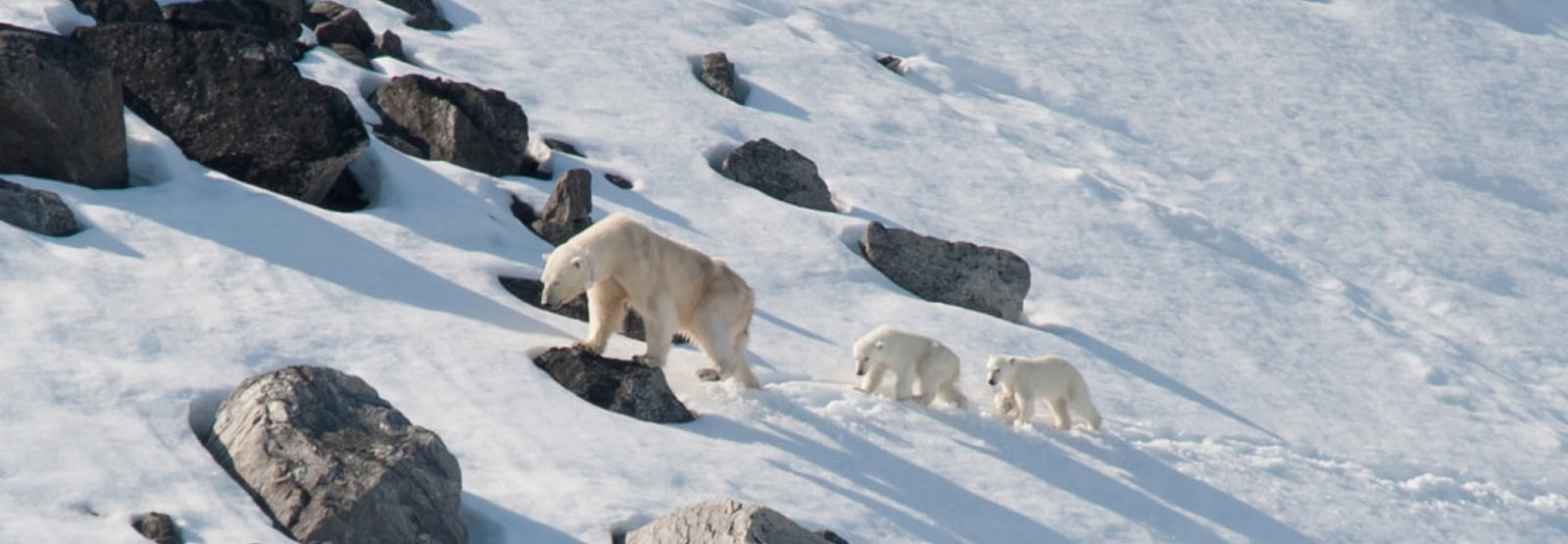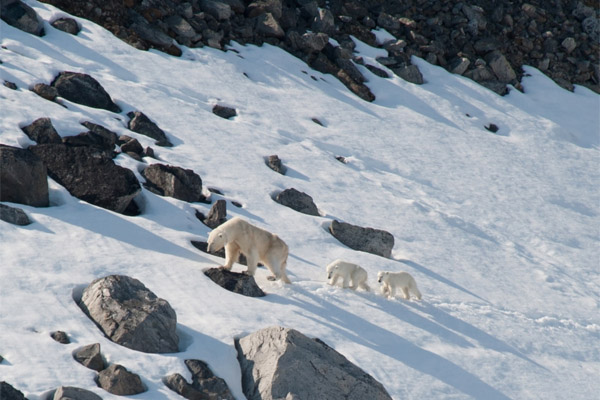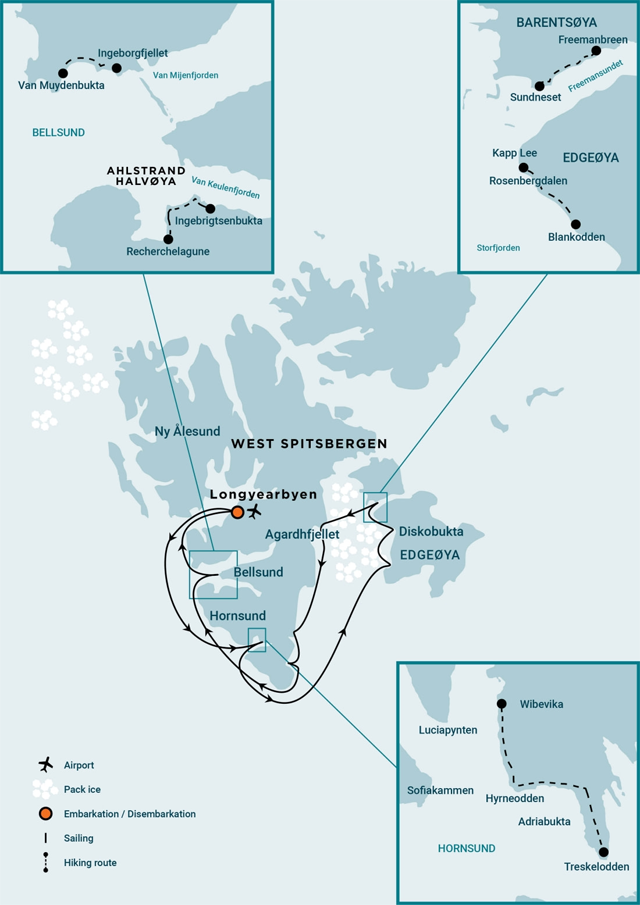DATES / RATES
Rates are listed per person in USD. Promotional offers are not reflected in the rates below.
|
| Start Date | End Date | Quadruple Porthole | Triple Porthole | Twin Porthole | Twin Window | Twin Deluxe | Superior |
|---|
| Jun 26, 2026 | Jul 03, 2026 | 4,450 | 5,550 | 6,150 | 6,700 | 7,100 | 8,050 |
Rates are listed per person in USD. Promotional offers are not reflected in the rates below.
|
| Start Date | End Date | (Starting from)
Quadruple Porthole | (Mid-range)
Twin Window | (High-end)
Superior |
|---|
| Jun 26, 2026 | Jul 03, 2026 | 4,450 | 6,700 | 8,050 |
ITINERARY
Long
hikes: -
Long
hikes are for groups of 24 passengers maximum, accompanied by two armed
expedition staff and a Zodiac that will sail ahead to watch for polar
bears along the shoreline. Passengers who join this activity should
have the willingness and ability to walk at least 15 km (9 miles) in
semi-rough terrain that includes shorelines, tundra, low hills, and
river crossings. Walks will take around six hours from start to finish,
rest times included. We will walk at a modest pace and not cross any
alpine terrain. Passengers who do not take part in long walks will have
a landing in the morning at the start point of the walk, then sail to
the end point of the walk for their second landing in the afternoon.
Cleaning
the shores of Spitsbergen: -
Interested
in doing something good for the environment?
We
welcome you to participate in our ongoing effort to remove plastic
waste and other rubbish from the shores of Spitsbergen.
Garbage
from the ocean, such as fishing gear and plastic litter, piles up on
these shores. This litter is hazardous to the animals, which get
entangled in fish nets and sometimes ingest micro-plastics that can
lead to starvation and suffocation.
Supported
by AECO and the governor of Spitsbergen, we enjoy cleaning the beaches
of Svalbard with our passengers. All participants will be assisted by
our guides and provided with collection bags. About 50 passengers will
clean in the morning while the other 50 have their excursion in another
area. Then in the afternoon, the groups switch roles. And if we cannot
clean a certain area because of roaming bears or other concerns, we
will find an alternate area.
Day
1: Largest town, biggest island
You
touch down in Longyearbyen, the administrative center of Spitsbergen,
the largest island of the Svalbard archipelago. Enjoy strolling around
this former mining town, whose parish church and Svalbard Museum make
for fascinating attractions.
Though
the countryside appears stark, more than a hundred species of plant
have been recorded in it. In the early evening the ship sails out of
Isfjorden, where you might spot the first minke whale of your voyage.
Day
2: Spectacular Hornsund
We
start the day by quietly cruising the side fjords of the spectacular
Hornsund area in southern Spitsbergen, enjoying the scenery of towering
mountain peaks. The mountain of Hornsundtind rises to 1,431 meters
(4,695 feet), while the peak of Bautaen testifies to why early Dutch
explorers gave this island the name Spitsbergen, meaning
“pointed mountains.”
There
are 14 magnificent glaciers in the area, and we have a fair chance of
encountering seals and polar bears.
The
nearby cliffs of Sofiakammen are also home to thousands of pairs of
nesting kittiwakes and little auks, and in the evening, we might see
thousands of harp seals rutting on ice floes at Sørkapp.
Long
hike - If
conditions permit, we land at Treskelodden, then walk from Treskelen to
Adriabukta. From there we walk west to Hyrneodden and north to the
glacier in Wibewika (about 16 km / 10 miles), where we will be picked
up. The other guests will have their program in Brepollen (morning) and
Luciakammen or Sofiakammen (afternoon). We might also do this program
in reverse.
Day
3: Long excursion at Diskobukta
After
navigating the drift ice of Storfjorden, where we sometimes see harp
seals, we land in northwest Edgeøya at the northern bank of
Rosenberdalriver. Here on the raised beach, we have the opportunity of
walking to Rosenbergdalen, which is teeming with grazing reindeer.
Afterward
we plan to walk by a cliff with nesting black guillemots on our way to
Stretehamna, where we often find a herd of walruses on the beach near
an octagonal trapper’s cabin built in 1905.
We
can also see the remains of a 19th-century Pomor house as well as the
bones of walruses hunted in previous centuries.
Long
hike - If
conditions permit, we land at Blankoddden, near a large kittiwake
colony in a beautiful canyon, then walk north along the coast to Kapp
Lee (about 20 km / 12.4 miles) or to the south side of Rosenbergdalen
(about 17 km / 10.6 miles), where we will be picked up. We might also
do this program in reverse.
If
this long hike is not possible, we might offer an alternative hike on
day 4.
Day
4: Trapper´s history in Freemansundet
Sailing
into the waterway of Freemansundet, we plan to land at the tundra
lowland of Sundneset, on the island of Barentsøya.
Here
we will visit the hut of a German scientific expedition
(Würzbugerhütte) from sixty years ago, then take a
brisk walk across the tundra in search of Spitsbergen reindeer and
barnacle geese. After that, we plan to go on a Zodiac cruise near
Freeman Glacier and visit a kittiwake colony in a canyon close by.
In
case of heavy ice in Freemandundet, however, we will instead sail to
Negribreen, one of the most extensive glacier fronts on the east side
of Spitsbergen. Here we can take a Zodiac cruise and land on Walrus
Island, which became ice-free at the end of last century.
Long
hike - If
conditions permit, we land in Barentsøya, near small lakes
with wildfowl and waders, then walk east along the coast of
Barentsøya to Freemanbreen. After about 10 km (6.2 miles),
we will pass a colony of kittiwakes. After another 10 km walk, we will
be picked up at the west side of Freemanbreen. This is a good area to
spot polar bears. We might also do this program in reverse.
Day
5: Ivory gulls in Agardhfjellet
Today
we sail to the east side of west Spitsbergen (west side of Storfjorden).
Here
we plan to walk to breeding places for ivory gulls in Agardhfjellet,
which stands about 300 meters (980 feet) high.
The
valley leading to the outcrops that house the nests is littered with
fossils of belemnites and ammonites.
Day
6: South Spitsbergen
Today
we aim to land at the mountain of Stellingfjellet, near the largest
colony of Brünnich’s guillemots in Spitsbergen.
Later in the day, we will make landings at the rarely visited coast of
south Spitsbergen, at the bay of Isbukta.
Day
7: Bell Sund’s flora, fauna, and haunting history
We
continue our voyage in Bell Sund, one of the largest fjord systems in
Svalbard. The ocean currents make this area slightly warmer than other
areas in the archipelago, which shows in the relatively lush vegetation.
Here
there are excellent opportunities to enjoy both history and wildlife.
A
possibility is Ahlstrandhalvøya, at the mouth of Van
Keulenfjorden, where piles of beluga skeletons can be found. These
remains of 19th-century whale slaughter are a haunting reminder of the
consequences of rampant exploitation. Fortunately, belugas were not
hunted into extinction, and you have a good chance of coming across a
pod.
Alternately,
while cruising the side fjords of Bellsund, we can explore tundra where
reindeer like to feed as well as rock slopes where little auks are
breeding.
Long
hike - If
conditions permit, we land at Recherchelagune and walk along the
eastern shore of Recherchefjord, by Laegerneset (17th century whaling
station). Our goal is to reach Ahlstrandhalvøya, and from
there to Ingebrigtsenbukta. If need be, our Zodiacs can help us at the
mouth of the river. We might also do this hike in reverse or land at
Ingeborgfjellet, then walk along the coast to the west side of van
Muydenbukta, along a shore with many whale skeletons.
Day
8: There and back again
Every
adventure, no matter how grand, must eventually come to an end. You
disembark in Longyearbyen, taking home memories that will accompany you
wherever your next adventure lies.
Ortelius (Expedition, 108-guests)
Ortelius offers a comfortable hotel standard, with a u-shaped, a bar and a lecture room. Our voyages are primarily developed to offer our passengers a quality exploratory wildlife program, trying to spend as much time ashore as possible. As the number of passengers is limited to approximately 116 on the Ortelius, flexibility assures maximum wildlife opportunities. Ortelius carries 10 zodiacs
 (Click image to view Ship details)
(Click image to view Ship details)
WHAT'S INCLUDED
- Voyage aboard the indicated vessel as indicated in the
itinerary
- All meals throughout the voyage aboard the ship including
snacks, coffee and tea.
- All shore excursions and activities throughout the voyage
by Zodiac.
- Program of lectures by noted naturalists and leadership by
experienced expedition staff.
- Free use of rubber boots and snowshoes.
- Transfers and baggage handling between the airport, hotels
and ship only for those passengers on the group flights to and from
Longyearbyen.
- All miscellaneous service taxes and port charges throughout
the programme.
- AECO fees and governmental taxes.
- Comprehensive pre-departure material.
Excluded
from this voyage
- Any airfare, whether on scheduled or charter flights
- Pre- and post- land arrangements.
- Passport and visa expenses.
- Government arrival and departure taxes.
- Meals ashore.
- Baggage, cancellation and personal insurance (which is
strongly recommended).
- Excess baggage charges and all items of a personal nature
such as laundry, bar, beverage charges and telecommunication charges.
- The customary gratuity at the end of the voyages for
stewards and other service personnel aboard (guidelines will be
provided).




